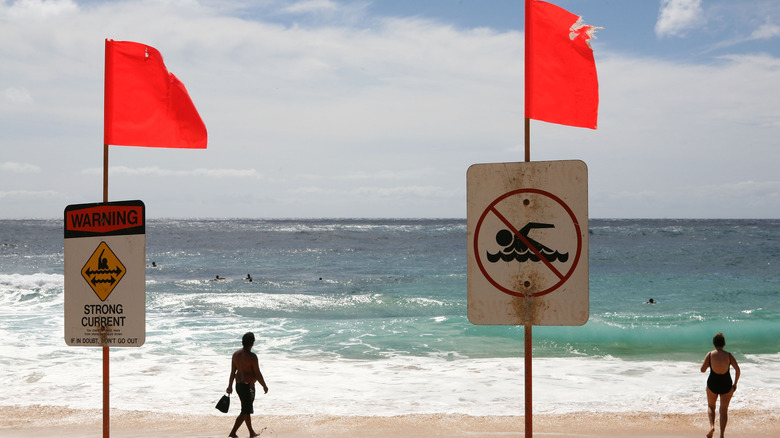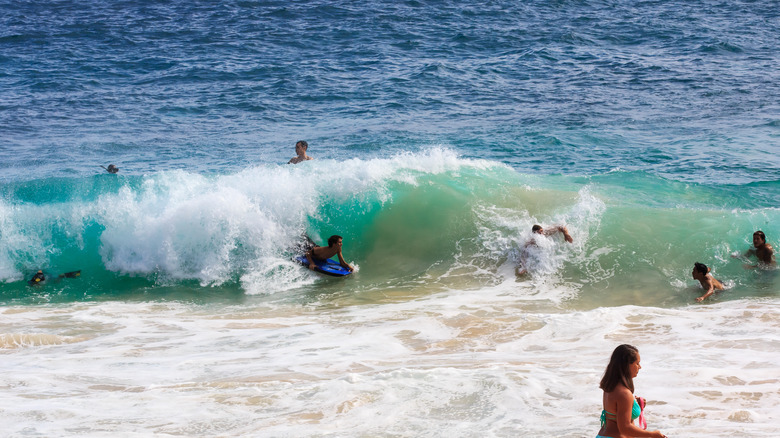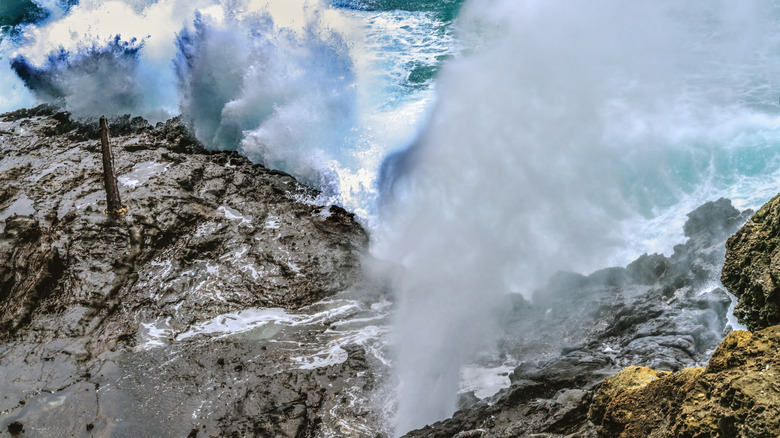This Hawaiian Beach Is Famous For Breaking Necks
The common stereotype of surfing is that it is a laid-back, free-spirited activity, which doesn't always sit comfortably with the considerable dangers that surfers face every time they head out onto the waves. The ocean is a wild and unpredictable force of nature. Some waves are powerful enough to break bones, and there is the ever-present threat of drowning if you're unfortunate enough to get pinned down or trapped beneath the surface. Riptides can drag you out to sea and the surf may disguise dangerous rocks on the seabed. Even your own board can present a threat if you wipeout or if the sea decides to hurl it at you. That's all before we get around to things that live in the ocean, not least sharks — we've all seen those scary pictures of the creatures lurking in waves next to surfers doing their thing.
For all the hazards, the global fatality rate for surfers is actually very low, with only around 10 people losing their lives each year out of the approximately 25 million people who partake in the sport. Perhaps the danger feels more acute because when someone does perish in a big wave, it tends to be a dramatic and terrifying way to go. Not all surfing spots are the same, with many factors contributing to the kind of waves that surfers encounter. One beach in Hawaii has a particularly bad reputation, to the point that it has earned the nicknamed "Broke Neck Beach."
How Broke Neck Beach got its nickname
Dangerous surfing spots around the world have picked up a range of daunting nicknames. There's Jaws in Hawaii, gaining its moniker for dangerously snapping shut on surfers (rather than any association with Steven Spielberg's classic movie). Then you have The Box in Australia, Mavericks in California, and the Dungeons in South Africa.
Joining this list of scary-sounding names is Sandy Beach Park, aka Broke Neck Beach — one of many dangerous places to swim in Hawaii. Located on the southeast tip of Oahu just a 20-minute drive from Honolulu, Sandy Beach is a gorgeous broad sweep of golden sand set against a rocky backdrop. It is popular with adrenaline-seekers because waves coming in from deep water can pile up quickly when they hit the shallows and break very close to the shore, making it a great spot for body surfing and boogie boarding.
Sandy Beach's spectacular waves are not to be taken lightly, and its frequent warning signs along the sand are there for a very serious reason. According to the lifeguards who patrol the beach, the surf here has tremendous "punching power," and injuries occur when big waves break on people in shallow water. This results in the highest number of back and neck injuries of their kind in the United States. Paralysis or even death has been the outcome in the past.
Other dangers at Sandy Beach Park
Red warning flags are visible most days throughout the year on Sandy Beach and — on the rare occasions that the sea is calm — there are still dangers present. Lethal rip currents can drag the unwary out to sea, and sharp coral beneath the surface can cause nasty injuries. You don't even need to venture into the water to get yourself in trouble. Nearby is the famous Halona Blowhole, where incoming swells crash into a coastal cave and blast water high into the air through a hole in the rocks with a force stronger than a firehose. There is a safe lookout point, but the temptation has proven too much for some people in the past. Injuries occur when people get too close, and one man was tragically washed into the cave and drowned.
Sandy Beach Park has basic facilities including restrooms and showers, but the most important are its two lifeguard stations. Even experienced professionals can get caught out by the surf at Broke Neck Beach and Hawaiian lifeguards work their way up to patrolling its shores. Nowadays, they seek to educate people on the sand before they venture into the water rather than wait to fish them out.
Sandy Beach is a beautiful spot to spend a day by the sea, but it has earned its infamous nickname over the years. Even if you have plenty of experience, it's perhaps best to leave this surf alone.


